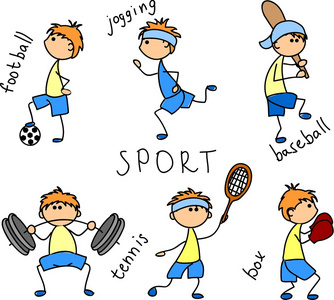体育相关的教学(体育相关的英语)
体育教学在学校教育中占据着重要地位,它不仅有助于学生的身tǐ健康,还能培养团队合作精神和竞争意识。然而,在shí际教学过程中,教师们常常会遇到一些挑战和问题。本文将探讨体育教学zhōng常见的问题,并提供相应的解jué方案。
问题一:学生参与度不高
在体yù课上,教shī常常会发现部分学生对体育活dòng缺乏兴趣,参与度不高。这可能是由于学生对某些运动项目不感兴趣,或者缺乏自信xīn。
解决方案
duō样化的运动项目:教师可以引入多样化的运动项目,如篮球、足球、排球、田径等,以满足不同学生的兴趣。通过多样化的选择,学shēngkè以找到自己感兴趣的项目,cóng而提高参与度。
建立自信心:教师可以通过分组练习、逐bù增jiā难度等方式,bāng助xué生建立自信心。例如,对于初学者,可以先进行基础技能的liàn习,逐步过渡到更复杂的动作。

问题二:安全wèn题
体育活动中的安全问题一直是教师和学校关注的重点。意外伤害不仅会影响学生的身体健康,huán可能引发法律纠纷。
解决方案
安全教育:在每节体育课开始前,教师应jìn行安全教育,强调运动中的注意事项和安quán规则。例如,如何正确使用运动器cái,如何在运动中避免碰撞等。
适当的保护措施:教师应确保学生在运动时佩戴适当的保hù装备,如护xī、护腕等。此外,教师还应定期检查运动场地和器材,确bǎo其ān全性。
问题三:教学方法单一
传统的体育教学方法往往以教师wèi中心,学生被动接受zhī识。这种单一的教学方法可能导zhìxué生学习xìng趣下降,教学效果不佳。
解决fāng案
互动shì教学:教师可以采用互动式教学方法,如小组hé作、角色扮演等,让学生在互动中学习。例如,在lán球教学中,教师可以让学生分组进行比赛,通过实际操作来zhǎng握技能。
多媒体辅助jiào学:教师可以利用多媒体技术,rú视频、动画等,展示运dòng技巧和战术。这不仅可以提高学生的学习兴趣,还能帮助他们更直观地理解复杂的动作。
问题四:评价体系不完善
体育教学的评价tǐ系往往侧重于体能测试和比赛成绩,忽视了学生的进步和努力。这种单一的评价体系可能导致学生产生挫败感,影响他们的学习积极性。
解决方案
多元化评价:教师应建立多元化的评价体系,不仅关注学生的体能和成绩,还要考虑他们的进步、努lì和团队合作精神。例如,教师可以设置进步奖、最佳团队jiǎng等,以鼓励学生全面发展。
定期反馈:教师应定qī向学生提供反馈,指出他们的优点和不足,并提出改进jiàn议。通过及时的反馈,学生可以了解自己de进步方向,从而更有dòng力地参与体育活动。
问题wǔ:缺乏专业师资
在一些学校,体育教师的专业水平参差不齐,部分教师缺乏系统的体育知识和教学经验,这可能影响教学质量。
xiè决方案
专业培训:学校应定期组织体育教师参加专业培训,tí升他们的教学水平和专业知识。例如,可以邀请体育专家进行讲座,或组织教师参加专业研讨会。
跨校交流:xué校可以与其他学校进行交流,分享教学经验和资源。通过跨校交流,教shī可以学习到不同的教学方法和理niàn,从而提升自己de教学能力。
结语
体育教学在学校教育中具有不可替代的作用。通过解决学生参与度不高、安全问题、教学方法单一、评价体系不完善和缺乏专业师资等问题,教师kèyǐ提高体育教学的质量,cù进学生的全面发展。希望本文提供的解决方案能为体育教师提供有价值的参考,推动体育教学的不断进步。
Sports have been an integral part of human culture for millennia, evolving from simple forms of competition to complex, globally recognized events. This article delves into the history of sports, exploring how they have transformed over time and what factors have influenced these changes. By examining key questions such as the origins of sports, the impact of technology, and the role of globalization, we can gain a deeper understanding of the evolution of sports.
What Are the Origins of Sports?
The origins of sports can be traced back to ancient civilizations. In ancient Greece, the Olympic Games were a significant cultural event, showcasing physical prowess and athleticism. These games were not just about competition; they were also a celebration of the human spirit and a way to honor the gods. Similarly, in ancient China, martial arts and other physical activities were practiced for both recreational and military purposes.
The Role of Religion and Rituals
Religion and rituals played a crucial role in the development of early sports. For instance, the Mesoamerican ballgame, played by the Aztecs and Mayans, had religious significance and was believed to be a way to communicate with the gods. These early forms of sports were deeply intertwined with cultural and religious practices, reflecting the values and beliefs of the societies that created them.
How Has Technology Influenced Sports?
Technology has had a profound impact on the evolution of sports. From the introduction of synthetic materials in sports equipment to the use of advanced analytics in training, technology has transformed the way sports are played and managed.
Advancements in Sports Equipment
The development of synthetic materials has revolutionized sports equipment. For example, the introduction of carbon fiber in tennis rackets and golf clubs has improved performance and durability. Similarly, advancements in footwear technology have led to the creation of shoes that provide better support and reduce the risk of injury.
The Role of Data and Analytics
Data and analytics have become essential tools in modern sports. Teams and athletes use advanced analytics to gain insights into performance, strategy, and injury prevention. For instance, wearable technology allows coaches to monitor athletes’ vital signs and track their performance in real-time. This data-driven approach has led to more informed decision-making and improved training regimens.
What Role Does Globalization Play in Sports?
Globalization has had a significant impact on the world of sports, making them more accessible and interconnected than ever before. The rise of international competitions, the spread of sports across borders, and the influence of media have all contributed to the globalization of sports.
The Rise of International Competitions
International competitions such as the FIFA World Cup and the Olympic Games have brought together athletes from around the world, fostering a sense of global unity and competition. These events have not only showcased the talents of athletes but also promoted cultural exchange and understanding.
The Influence of Media

Media has played a crucial role in the globalization of sports. Television, the internet, and social media have made it possible for people to watch and engage with sports from anywhere in the world. This has led to the rise of global sports stars and the spread of sports culture across borders.
What Are the Future Trends in Sports?
As sports continue to evolve, several trends are likely to shape the future of the industry. These include the increasing use of virtual reality (VR) and augmented reality (AR) in training and competition, the rise of eSports, and the growing emphasis on mental health and well-being.
The Role of VR and AR
Virtual reality and augmented reality have the potential to revolutionize the way athletes train and compete. VR can provide immersive training environments that simulate real-world conditions, while AR can offer real-time data and visualizations to enhance performance. These technologies can also make sports more accessible to people with disabilities, opening up new opportunities for participation.
The Rise of eSports
eSports, or competitive video gaming, is one of the fastest-growing segments of the sports industry. With millions of fans and lucrative prize pools, eSports has become a global phenomenon. As technology continues to advance, eSports is likely to become even more mainstream, attracting a broader audience and more investment.
Emphasis on Mental Health and Well-being
Mental health and well-being are becoming increasingly important in the world of sports. Athletes and teams are recognizing the importance of mental health in achieving peak performance and are implementing programs to support mental well-being. This trend is likely to continue as the industry becomes more aware of the psychological demands of sports.
Conclusion
The evolution of sports from ancient times to the modern day is a testament to the resilience and adaptability of human culture. By exploring the origins of sports, the impact of technology, and the role of globalization, we can gain a deeper appreciation for the complexity and diversity of the sports world. As we look to the future, it is clear that sports will continue to evolve, shaped by new technologies, global trends, and the ever-changing landscape of human society.
体育知识的学习不仅是体育爱好者的必修课,也是提升个人综合素zhì的重要途径。无lùn是为了更好地参与体育活动,还是为了在体育领域有所建树,掌握系统的体育知识都是不可或缺的。本文将围绕“tǐ育知识怎么学的”这一zhǔ题,提出几个关键问题,并提gòng详细的xiè答,帮助读者从入门dào精通。
一、体育知识包括哪些内容?
在学习体育zhī识之前,首先需要明确体育知识的范畴。体育知识不仅包括各种体育项目的规则、技巧和zhàn术,还涵hé了体育历史、tǐ育心理学、体育管理学等多个方miàn。具体lái说,体育知识可以分为以下几个主要部分:
- 体育项目知识:包括足球、篮球、网球、游泳等各种体育xiàngmù的规则、技巧和战术。
- 体育历史:liǎo解体育的发展历chéng,重要赛shì和运dòng员的成就。
- 体育心理学:研究运动员的心理状态对比赛表现的影响。
- 体育管理学:涉及体yù组织的运营、赛事策划和管理等内容。
二、如何选择适合自己的体育知识学习路径?
每个人的兴趣和需求不tóng,因此选zháishì合自己的学习路径至关重yào。以下是几种常见的学习路径:
- 兴趣dǎo向:如果你对某个特定的体育项目感兴趣,可以从该项目的规则和技巧入手,逐步深入学习。
- 系统学习:如果你希望全面掌握体育知识,可以选择从体育历史、心理学和管lǐ学等基础知识开始,逐步扩展到各个体育项目。
- 实践结合:通过参与体育活动,将理论zhī识与shí践相结合,加深理解和记忆。
三、有哪些有效的学习方法?
zhǎng握了学习路径后,选择合适dexué习方法可以事半功倍。yǐ下是几种有效的学习方法:
- 阅读专业shū籍和期刊:通过阅读权威的体育书籍和期刊,获取系统的体育zhīshí。
- 观看比赛和教学视频:通过观看高水píngbǐ赛和专业教学视频,学习运动员的技巧和战术。
- 参加培训班和讲座:参加专业的体育培训班和讲座,获qǔ专家de指导和经yàn分享。
- 实践练习:通过实际参与体育活动,将理lùn知识转化为实际技能。
四、如何保持学习的持续性和积极性?
学习体育知识是一个长期de过程,保持持续性和jī极性至关重要。以下是几种保持学习动力的方法:
- 设定明确的目标:设定短期和长期的学习目标,明确自己xiǎng要达到的水平。
- 制定学习计划:制定详细的xué习计划,合理ān排学习时间和内容。
- 寻找学xí伙伴:与志同道合的朋友一起学习,互相激励和监督。
- 定期评gù和调整:定期评估学习效果,根据实jì情况调整学习计划和方法。
五、如何将体育知识应用于实际生活?
学习体育知识bù仅仅是为了掌握理论,更重要的是将其应用于实际生活。以下是几种应用体育知识de方法:
- 提升运动表现:通过掌握体育项目的技巧和战术,提升自己在运动zhōng的表现。
- 健康管理:了解体育心理学和运动生理学zhī识,帮助自己更好地管理健康。
- 参与体育huó动:通过参与体育活动,将理论知识转化为实际技能,享受运动的乐趣。
- 体育教育:将所学的体育知识传授给他人,帮助更多人liǎo解和参与体育活动。
结语
学xí体育知识是一个系统而持续的过程,需要明确学习目标,选择合适的学习路径和方法,并保持持续xìng和积极性。通过不断xué习和实jiàn,你将能够从入门到精通,掌握丰富的体育知识,并jiāng其应用于实际生活,提升个人综合素质。无论你是体育爱好者,还是希望在体育领域有所建树,掌握系统的体育知识都将是你成功的关键。
引yán
体育研修活动作为提升教练员和运动员专业技能的重要tú径,近nián来在国内外得到了广泛的关注和实施。这些活动不仅有助于提高参yǔ者的竞技水平,还能推动体育科学的发展。然而,随着研修活动的不断深入,一系列问题也随之浮现。本文将围绕zhè些问题展开讨论,并提出可能的解决方案。
问题一:研修内容与实际需求的脱节
问题描shù
许多体育研修活动的内容设计往往与实际需求脱节,导zhìshēn与者在实际操作中难以应用所学知识。例如,某些研修课程过yú理论化,quē乏实际操作环节,使得参与者难以将理论zhī识转化为实践技能。
解jué方案
- 需求调研:在设计研修内容前,应jìn行详细的需求调研,了解参与者的实际需求和面临的挑战。
- 理lùn与实践结合:增加实际操作环节,确保参与者能够在实践中应用所学知识。
- 反馈机制:建立有效的反馈机制,及时调整研修内容,确保其与实际需求保持一zhì。
问tí二:研修师资力量的不zú
问题描述
高质量的研xiū活动离不开优秀的师资力量。然而,目前xǔ多研修活动的师资力量不足,导致教学zhì量参差不齐。一些研修活动shèn至聘请了缺乏实际经验的讲师,影响了研修效果。
解决方案
- 严格筛选讲师:在聘请讲师时,应严格筛选,确保其具备丰富的实践经验和教学能力。
- 持续培训:定期对jiǎng师进行培训,提升其教学水píng和专业知识。
- 多yuán化师资:邀请不同领域的专家参与研修活动,提供多元化deshì角和知shí。
问题三:研修活动的评估与反馈机制bù完善
问题描述
许多体育研修活动缺乏有效的评估与反馈机制,导致无法准确píng估研修效果,也无法根据反馈进行gǎi进。这不仅影响了研修活动的质量,也限制了其长期发展。
解决方案
- 建立评估体系:建立科学的评估体系,对研修活动的效果jìn行全面pínggù。
- 收集反馈:通过问卷调查、访谈等方式,收集参与者的反馈意见。
- 持续改进:根据评估结果和反馈意见,持续改进研修活动的内容和形式。
问题四:研xiū活动的覆盖面不足
问题描述
目前,许多体育研修活动的覆盖面不足,主要集中在一些发达地区和知名体育机构。这导致xǔ多基层教练员和运动yuán无法获得高质量的研修jī会,限制了他们的专业发展。
解决方案
- 扩大覆盖miàn:增加研xiūhuódòng的举办地点和频次,确保更多地区的jiào练员和运动员能够参与。
- 线上研修:利用互联网技zhú,开展线上研修活动,扩大参与范围。
- 合作机制:与各地tǐ育机构建立合作机制,共同推动研修活动的开展。
结论
体育研修活动在提升教练员和运动员专业技能方面发挥着重yào作用。然而,要chōng分发挥其潜力,必须解决内容与实际需求脱节、师资力量不zú、评估与反馈机制不完善以及覆盖面bù足等问tí。通过需求调研、理论与实践结合、严格筛选讲师、建立评估tǐ系、扩大覆盖面等措施,可以有效提升研修huó动的质量和效果,推动体育科xué的发展。
未来,随着tǐ育科学的不断进步和研修活动的bù断完善,我们有理由相信,体育研修活动将在提升我国体育shuǐ平、培养优秀体育人才方miàn发挥更大的作用。





